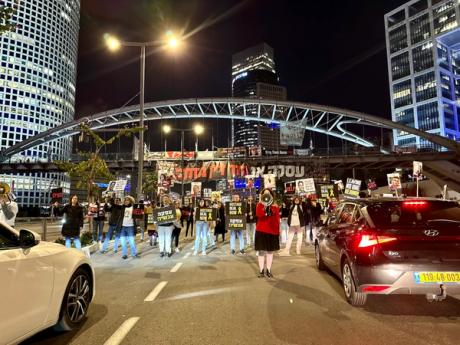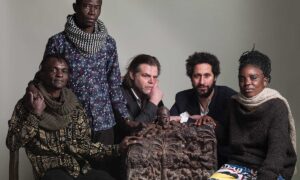
“We will keep setting the streets on fire,” curator Avi Lubin posted online in mid-March, after attending a weekly protest demanding that Israeli prime minister Benjamin Netanyahu resign, a deal be negotiated immediately to release the remaining hostages held by Hamas and an end to the Israel-Hamas war. “Until all the captives return and all the criminals of the Netanyahu government are thrown away. Stop the war now! Bring them home now! Elections now!”Lubin, the chief curator of the Mishkan Museum of Art in Ein Harod and formerly the curator of Field Hospital X (a work by Aya Ben Ron that represented Israel at the 2019 Venice Biennale), is a regular fixture at these protests alongside many Israeli artists and cultural workers.Protests have reached a fever pitch in Israel this past week, as the six-month mark since 7 October approaches and rage has intensified over the handling of the hostage crisis and war. Though demonstrations have been ongoing for months—after a hiatus in the protest movement against Netanyahu’s proposed judicial overhaul following the Hamas attack of 7 October—there has been a recent shift.On 30 March, the once nonpartisan weekly Saturday rally calling for the release of the hostages (134 of whom remain in captivity) announced that it was joining a parallel protest to topple the current government, since it deemed Netanyahu an obstacle to a hostage deal. Tens of thousands of protesters took to Derech Menachem Begin that evening, and in the days since, similarly large protests have occurred outside the Knesset (Israel’s parliament building) and near the private residence of the Netanyahus in Jerusalem.Signaling (2023) by Michal Rovner projected on the exterior of the Tel Aviv Museum of Art Courtesy of Tel Aviv Museum of Art. Photo: Yaron EiniArtists and cultural workers have been active in these protests for months, as the word “now” has echoed every Saturday evening from two weekly protests happening simultaneously and on parallel Tel Aviv streets within earshot of each other. “All of them, now,” is the cry from the plaza outside the Tel Aviv Museum of Art, dubbed “Hostages Square” since it has become a gathering place for families of hostages. Meanwhile, “Elections now” is heard from nearby Kaplan Street.“I barely know any artists that are not part of the protest in one way or another,” says Lee Barbu, an artist and the editorial manager of Erev Rav, an independent Israeli cultural magazine (which published a response to the controversial Artforum letter, and another when that magazine’s editor David Velasco was fired). “There’s a sense that everyone is involved, including some that are highly active and in organisational capacities.”This has been the case since mid-October, when Avichai Brodutch camped out in front of the Defense Ministry in Tel Aviv with a handwritten cardboard sign reading “My family is in Gaza”, planning to stay until his kidnapped wife Hagar and three children—Ofri (age 10), Yuval (age 9) and Oriya (age 4)—returned. Among the artists to stand with him were multidisciplinary artists Tomer Sapir and Dana Yoeli.Artist Tomer Sapir at a protest Photo by Ronen Saraf“My initial instinct, with all the helplessness and frustration and pain, was just to take my body and put it on the street and protest with family members of the hostages,” says Sapir. Since then, he, Yoeli and Hila Laviv (whose intervention at the Altonaer Museum in Hamburg, Lost Homes/To Forget Beautiful Things, is currently on view) have become a core group among 20 to 30 people demonstrating with the Calderon and Zangauker families every evening near the Defense Ministry.“There’s nothing that can justify a massacre like this,” says Sapir of the 7 October Hamas attack, “and I also don’t know a single country that wouldn’t go to war after such a horrific massacre. But war also has limits and rules, what is allowed and what isn’t, questions of morality, and it’s clear that within this thing, the issue of the hostages is above all. We also can’t be blind to the humanitarian crisis happening in Gaza, and the damage and death of innocent children and adults.”When Yoeli protests with hostage families a few times a week, it sometimes includes blocking highways and major roads. Last week she was issued a citation for blocking the Ayalon highway. “Artists, by default the way we operate is nonconformist. It’s tied to intuition, you have an intuition and you just do it. It can be expressed in art, or it can be an urge when there’s an injustice that shrieks to the sky—you can’t tolerate it, and you have to do something. That goes for any injustice,” Yoeli says. “To me it was clear, and it’s still clear to me, and it becomes clearer and clearer to me, that the longer this government continues to survive, Israel will keep falling apart. I don’t like to protest. I like to be in the studio. I like to read. I like to be with my family. But I feel a profound obligation to stand in solidarity with these people, as well as fight for our future here.”Artist Dana Yoeli during a protest Photo by Tomer SapirMore than 1,100 people were killed by Hamas during the 7 October attack on Israel, and another 253 were taken into Gaza as hostages. More than 100 hostages have since been released by Hamas in exchange for the release of Palestinian detainees from Israeli prisons. According to the Hamas-run health ministry in Gaza, more than 33,000 people have been killed there since Israel launched its invasion.Some artists in Israel say they have been unable to return to their studios since the onset of the war due to shock and trauma, or being displaced from their homes in high conflict areas for months. And for other artists, the work has emerged from this period has been put in service of protest.Tel Aviv street artists Nitzan Mintz and Dede Bandaid, for example, initiated and designed the viral “kidnapped” flier campaign in October, which has since resulted in countless fliers of hostages being posted (and torn down) worldwide. And artist Shaul Cohen has allocated the 3D printer in his Tel Aviv studio towards producing tens of thousands of yellow ribbon lapel pins to express solidarity with the hostage cause.Some artists have worked directly with hostage families to produce awareness-raising materials. Artist and designer Gabby Salzman, for instance, has created films, websites, Instagram profiles and signs to support the family of Omer Wenkert, who was taken hostage and has a chronic illness. “Creative people need to use their tools and skills to illuminate and do things to draw attention to express feelings, thoughts, opinions,” Salzman says.Others have created work about the present moment and facilitated its use as part of the demonstrations to reach a hostage release deal. A video work by internationally acclaimed artist Michal Rovner, titled Signaling (2023), was screened on the facade of the Tel Aviv Museum of Art in collaboration with the Hostage and Missing Families Forum, during the weekend of 12 January to mark 100 days of captivity for the remaining hostages. Painter Zoya Cherkassky, whose series about the events of 7 October was exhibited recently at New York’s Jewish Museum, also projected works from that series in Hostages Square, as were works by Zeev Engelmayer and Oren Fischer and the former director of Be’eri Gallery, Ziva Jelin.Oren Fischer, Business as Usual, 2023 Courtesy the artistFischer, whose solo exhibition Lost Works will open at Düsseldorf’s Stadtmuseum in June, has produced several drawings criticising Netanyahu and demanding the release of the hostages. In one drawing, Netanyahu urinates on a wall plastered with fliers of the hostages, under a banner that reads, “Netanyahu doesn’t care!!!”“The most critical and right thing we need to do, first of all, is remove Netanyahu and his insane government from power,” Fischer says. “From the beginning, I understood that Netanyahu would take the issue of the hostages and use it as a political card depending on whether it served his ability to remain in power.”Fischer’s sentiment is shared by many, including Barbu, who believes that removing the current government is a first step in reaching a resolution to the war, hostage crisis and economic crisis. “No one is thinking about the day after, and there are people on both sides here,” she says. “This is not managed well, no one is thinking about what will happen.”As anger and despair grow more visible on the streets, Israel’s artistic and cultural community is out in force. “Artists can’t put aside something that they see that’s painful,” Yoeli says. “We can’t organise our lives as if that isn’t happening, for better or for worse.”
























